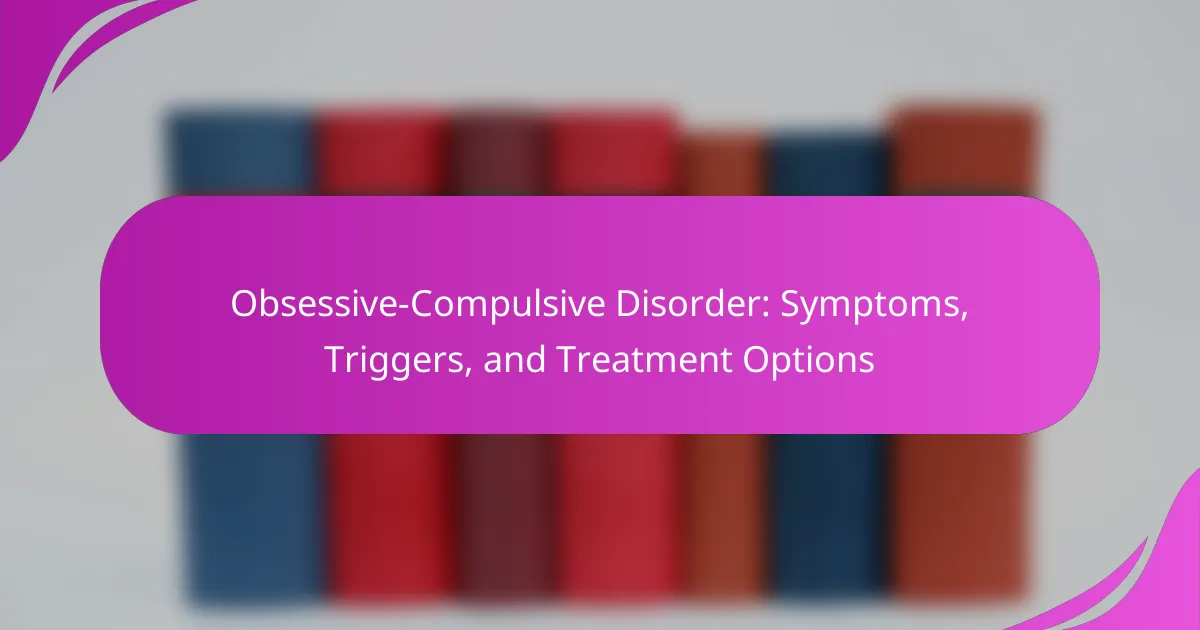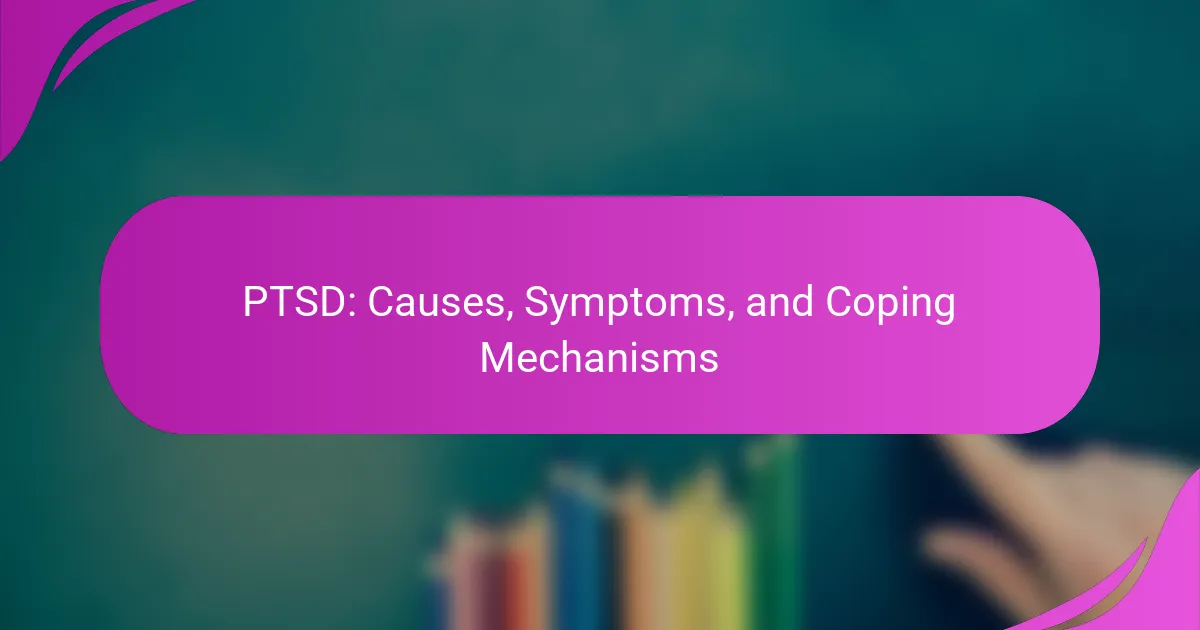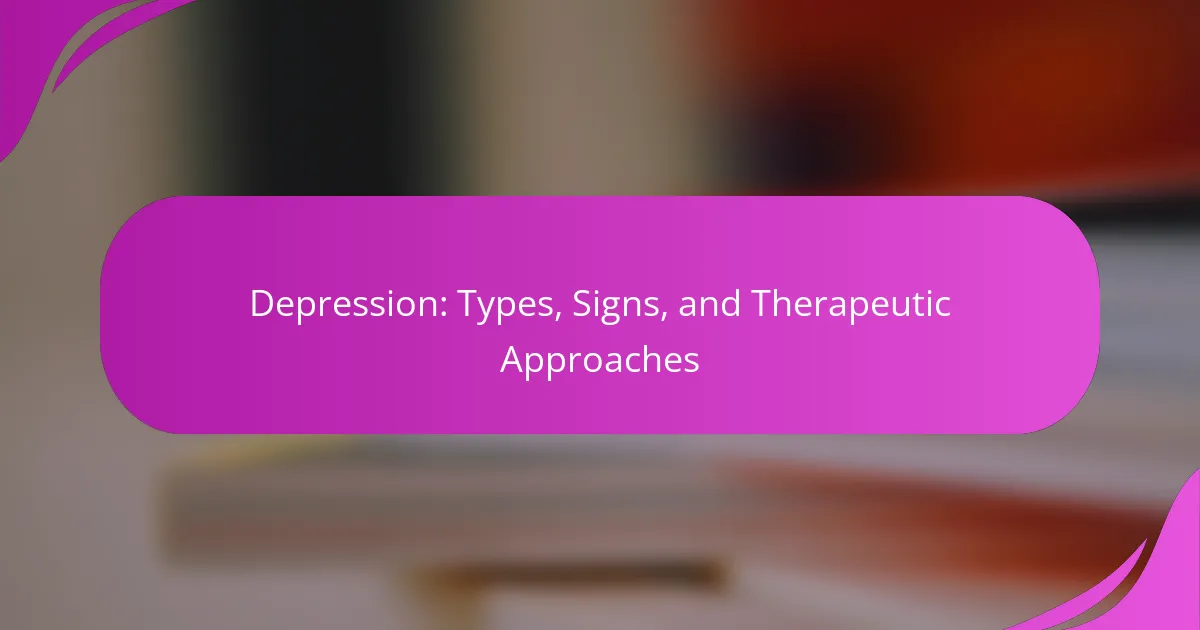Anxiety disorders can severely impact daily life, causing excessive worry and physical symptoms like increased heart rate. They arise from genetic, environmental, and psychological factors. Effective treatments include cognitive-behavioral therapy, medications, and lifestyle changes. Understanding the unique and rare attributes of these disorders is essential for tailored treatment strategies.
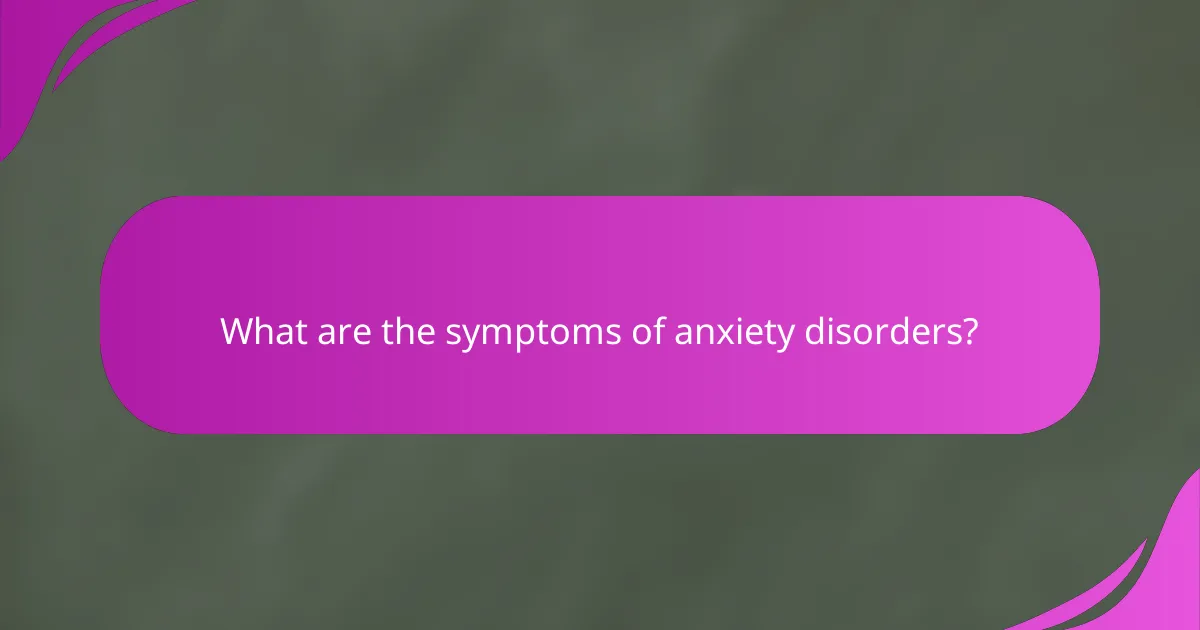
What are the symptoms of anxiety disorders?
Anxiety disorders manifest through various symptoms, including excessive worry, restlessness, fatigue, difficulty concentrating, irritability, and sleep disturbances. Physical symptoms may include increased heart rate, sweating, trembling, and muscle tension. These symptoms can significantly impact daily functioning and quality of life.
How do symptoms vary across different anxiety disorders?
Symptoms of anxiety disorders vary significantly, reflecting different underlying causes and experiences. Generalized Anxiety Disorder (GAD) often presents with persistent worry, fatigue, and irritability. Panic Disorder is characterized by sudden panic attacks, heart palpitations, and shortness of breath. Social Anxiety Disorder manifests as intense fear of social situations, leading to avoidance behaviors. Specific Phobias involve overwhelming fear of particular objects or situations, causing distress and avoidance. Each disorder has unique attributes that impact symptom expression and treatment approaches. Understanding these differences aids in effective management and support.
What physical symptoms are commonly associated with anxiety?
Common physical symptoms associated with anxiety include increased heart rate, muscle tension, sweating, and gastrointestinal issues. These symptoms can vary in intensity and may lead to significant discomfort.
Increased heart rate, also known as tachycardia, is a frequent response to anxiety, often resulting from the body’s fight-or-flight reaction. Muscle tension is another common symptom, causing discomfort and pain in various areas. Sweating, particularly in palms and underarms, can occur during anxiety episodes. Gastrointestinal issues, such as nausea or diarrhea, may arise due to the body’s stress response affecting digestion.
Recognizing these symptoms is crucial for effective treatment and management of anxiety disorders.
How do emotional symptoms manifest in individuals?
Emotional symptoms in individuals with anxiety disorders often manifest as excessive worry, restlessness, and irritability. These symptoms can lead to difficulty concentrating and feelings of impending doom. Anxiety can also cause social withdrawal and a sense of detachment from reality. As a result, individuals may experience heightened emotional sensitivity and mood swings, impacting daily functioning and relationships.
What behavioral changes can indicate anxiety disorders?
Behavioral changes indicating anxiety disorders include increased irritability, avoidance of social situations, and changes in sleep patterns. These alterations can manifest as excessive worrying or difficulty concentrating. Recognizing these signs is crucial for early intervention and effective treatment.
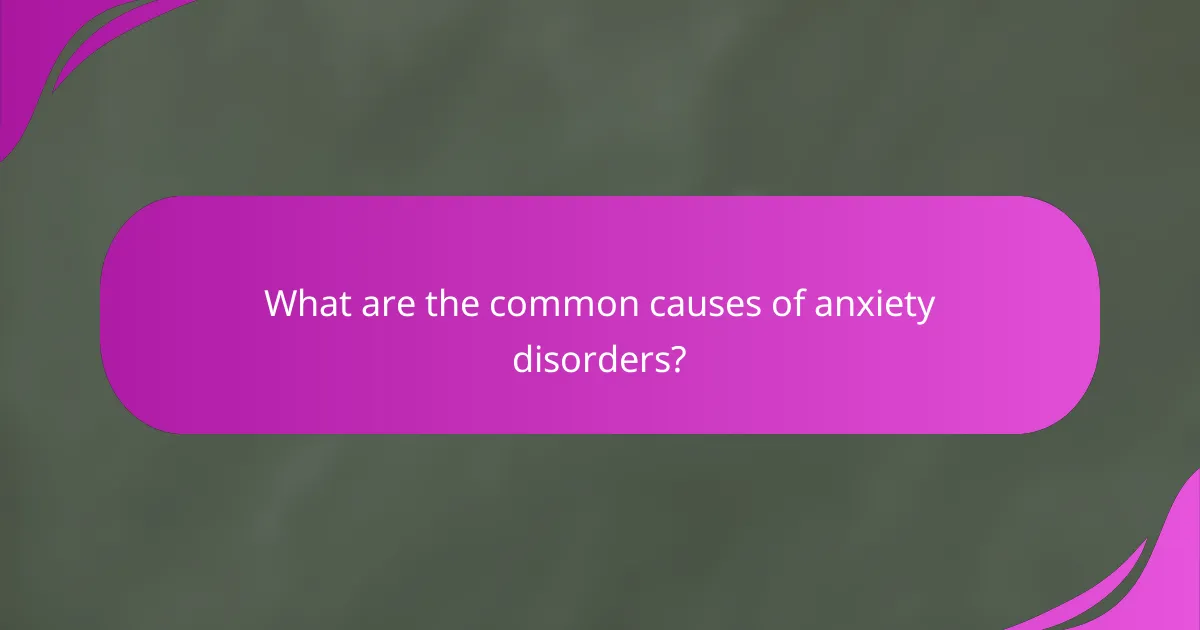
What are the common causes of anxiety disorders?
Anxiety disorders commonly arise from a combination of genetic, environmental, and psychological factors. Genetic predisposition, traumatic experiences, and chronic stress contribute significantly to their development. Additionally, imbalances in brain chemistry may play a crucial role in triggering these disorders.
How do genetic factors contribute to anxiety disorders?
Genetic factors significantly contribute to anxiety disorders by influencing brain chemistry and stress response. Research indicates that individuals with a family history of anxiety disorders have a higher risk, suggesting a hereditary component. Specific genes, such as those involved in serotonin regulation, have been linked to increased anxiety susceptibility. Environmental factors interact with these genetic predispositions, shaping the overall risk profile for anxiety disorders.
What role does environmental stress play in developing anxiety?
Environmental stress significantly contributes to the development of anxiety disorders. Factors such as chronic noise, pollution, and socioeconomic challenges can trigger or exacerbate anxiety symptoms. Research indicates that individuals exposed to high levels of environmental stressors are more likely to experience anxiety-related conditions. For instance, urban environments with elevated noise levels have been linked to increased anxiety prevalence. Additionally, unique attributes like personal resilience and coping mechanisms can influence how environmental stress impacts an individual. Understanding these dynamics is crucial for effective treatment strategies.
How can traumatic experiences lead to anxiety disorders?
Traumatic experiences can significantly contribute to the development of anxiety disorders. These experiences often trigger heightened stress responses, leading to symptoms such as excessive worry, panic attacks, and avoidance behaviors.
When individuals undergo trauma, their brain’s response to stress can become dysregulated. This dysregulation can manifest as persistent anxiety, affecting daily functioning. For instance, studies indicate that nearly 20% of individuals who experience trauma develop an anxiety disorder, highlighting the connection between trauma and anxiety.
Moreover, unique attributes of trauma, such as the severity and type of the event, can influence the likelihood of developing anxiety disorders. Events like physical assault or natural disasters often have a more profound impact than less severe experiences.
Understanding this relationship is crucial for effective treatment. Therapeutic approaches, including cognitive-behavioral therapy and exposure therapy, can help individuals process traumatic experiences and reduce anxiety symptoms.
What are the psychological factors that contribute to anxiety?
Psychological factors contributing to anxiety include negative thought patterns, excessive worry, and past trauma. These elements can create a cycle of fear and avoidance, exacerbating anxiety symptoms. Cognitive distortions, such as catastrophizing and overgeneralization, significantly influence how individuals perceive stressors. Additionally, a history of anxiety in family members can increase susceptibility, highlighting the role of genetics and environment in anxiety disorders. Understanding these factors is vital for effective treatment strategies.
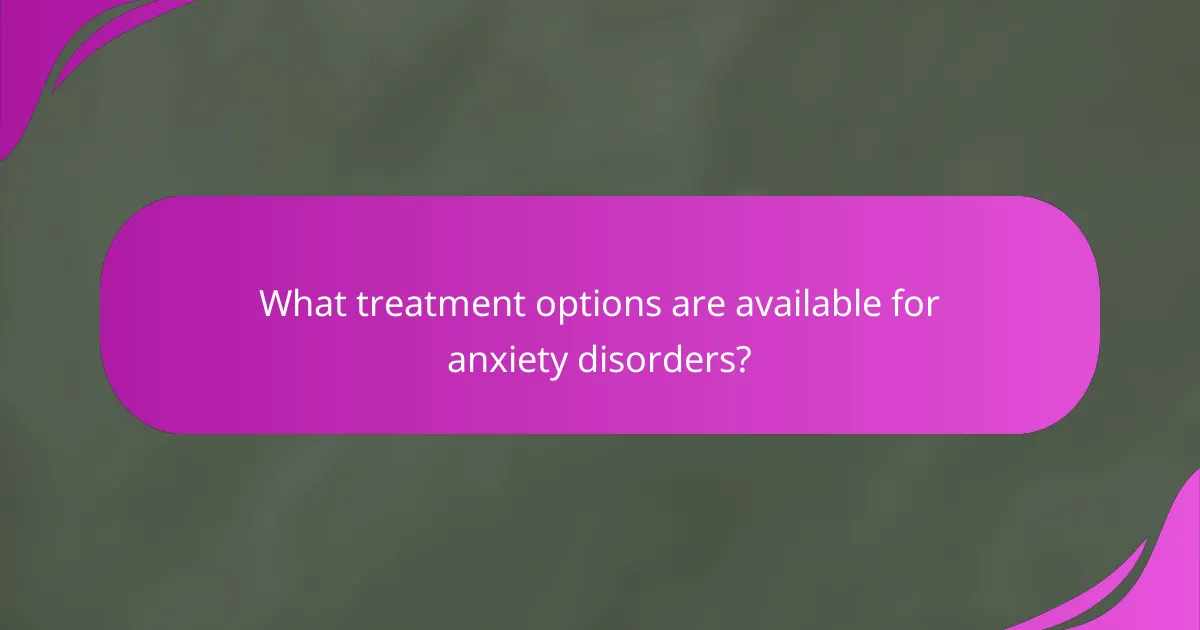
What treatment options are available for anxiety disorders?
Anxiety disorders can be treated with a variety of options, including therapy, medication, and lifestyle changes. Cognitive-behavioral therapy (CBT) is highly effective, focusing on changing negative thought patterns. Medications, such as selective serotonin reuptake inhibitors (SSRIs), can help manage symptoms. Additionally, lifestyle modifications like regular exercise and mindfulness practices can support overall mental health. Combining these approaches often yields the best results, addressing both root and unique attributes of anxiety disorders.
How effective are cognitive-behavioral therapies for anxiety?
Cognitive-behavioral therapies (CBT) are highly effective for treating anxiety disorders. Studies show that CBT can reduce anxiety symptoms in up to 75% of patients. This therapy focuses on changing negative thought patterns and behaviors, leading to improved coping strategies. Additionally, CBT is often preferred due to its structured approach and relatively short duration, typically lasting 12 to 20 sessions. Overall, CBT provides significant benefits, making it a first-line treatment for anxiety disorders.
What medications are commonly prescribed for anxiety disorders?
Common medications prescribed for anxiety disorders include selective serotonin reuptake inhibitors (SSRIs), benzodiazepines, and serotonin-norepinephrine reuptake inhibitors (SNRIs). SSRIs like fluoxetine and sertraline are often first-line treatments due to their effectiveness and lower side effect profile. Benzodiazepines, such as diazepam and lorazepam, provide rapid relief but carry risks of dependence. SNRIs like venlafaxine are also effective, particularly for generalized anxiety disorder. Each medication has unique attributes affecting patient choice and treatment outcomes.
How does exposure therapy work in treating anxiety?
Exposure therapy effectively treats anxiety by gradually exposing individuals to feared situations, helping them reduce anxiety responses. This method relies on principles of classical conditioning, where repeated exposure diminishes fear over time. Studies indicate that around 60-90% of individuals experience significant symptom reduction after completing exposure therapy. This therapy can be tailored to various anxiety disorders, making it a versatile treatment option. It is particularly effective for specific phobias and social anxiety, where unique attributes of the individual’s fears are addressed directly.
What alternative treatments exist for managing anxiety?
Alternative treatments for managing anxiety include cognitive-behavioral therapy, mindfulness meditation, herbal supplements, acupuncture, and yoga. These methods can complement traditional therapies. Cognitive-behavioral therapy focuses on changing negative thought patterns. Mindfulness meditation encourages present-moment awareness, reducing stress. Herbal supplements like chamomile and lavender may offer calming effects. Acupuncture targets specific points to alleviate anxiety symptoms. Yoga combines physical movement and breath control to promote relaxation. Each treatment varies in effectiveness based on individual needs and preferences.
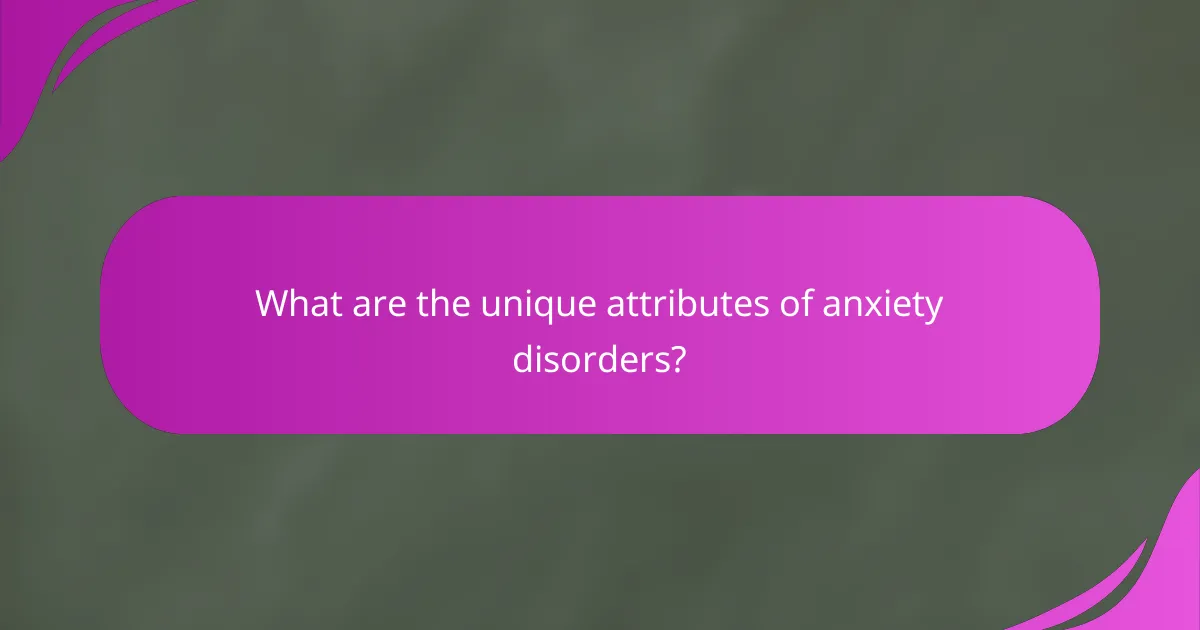
What are the unique attributes of anxiety disorders?
Anxiety disorders have several unique attributes that distinguish them from other mental health conditions. These include specific triggers, varying severity levels, and distinct physiological responses. For example, social anxiety disorder often manifests in situations involving public speaking or social interactions. Other unique attributes include the presence of comorbid conditions, such as depression, and the impact of genetic predisposition. Treatment responses can also vary significantly among individuals, highlighting the uniqueness of each case.
How do co-occurring disorders impact anxiety treatment?
Co-occurring disorders complicate anxiety treatment by introducing additional symptoms and treatment challenges. These disorders, such as depression or substance use disorders, can exacerbate anxiety symptoms and hinder recovery. Effective treatment requires integrated approaches that address both anxiety and the co-occurring condition simultaneously. This dual focus improves overall outcomes and enhances the effectiveness of therapeutic interventions.
What is the significance of diagnosis timing in anxiety disorders?
Timely diagnosis of anxiety disorders is crucial for effective treatment. Early identification allows for prompt intervention, which can significantly reduce symptom severity and improve overall outcomes. Delayed diagnosis may lead to worsening symptoms and comorbid conditions, impacting the individual’s quality of life. Research indicates that timely treatment can enhance recovery rates and decrease the duration of anxiety episodes.
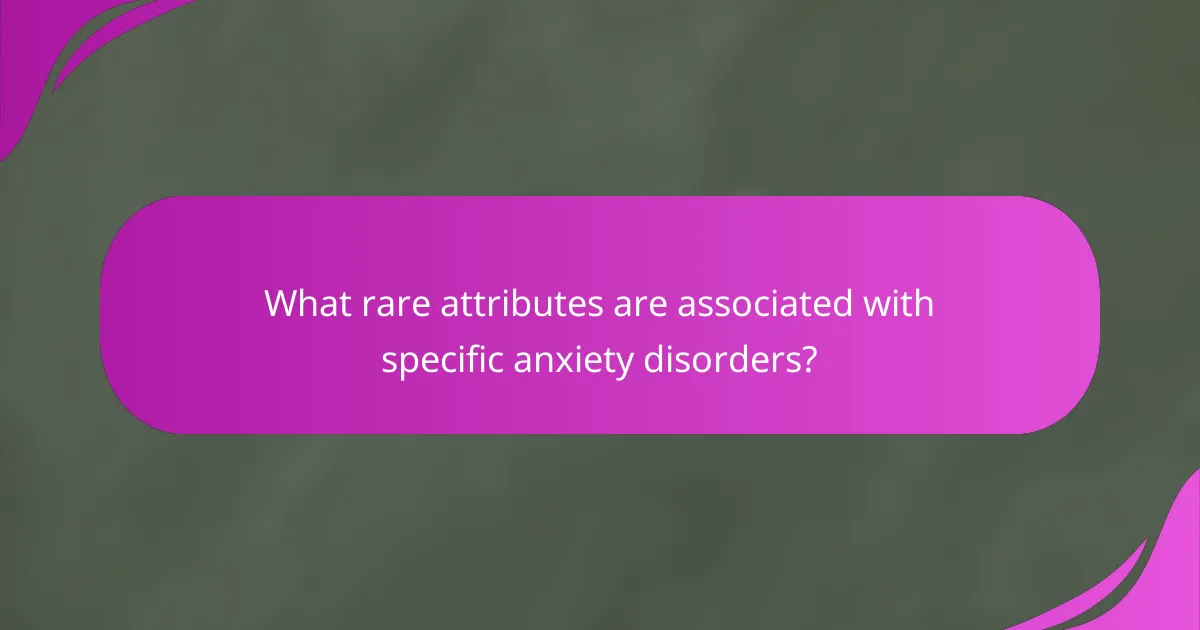
What rare attributes are associated with specific anxiety disorders?
Certain anxiety disorders exhibit rare attributes that can significantly impact diagnosis and treatment. For example, individuals with Social Anxiety Disorder may experience intense fear of specific social situations, which can manifest as physical symptoms like blushing or sweating. In contrast, those with Generalized Anxiety Disorder may have a unique attribute of pervasive worry that affects multiple aspects of life, such as work and relationships. Panic Disorder can include rare occurrences of agoraphobia, where individuals avoid places or situations that might trigger panic attacks. Understanding these rare attributes aids in tailoring effective treatment strategies.
How do cultural perceptions influence anxiety disorder symptoms?
Cultural perceptions significantly shape anxiety disorder symptoms by influencing how individuals express and cope with their feelings. For example, in collectivist cultures, symptoms may manifest as physical complaints, while in individualistic cultures, emotional expressions may be more accepted. Social stigma surrounding mental health varies across cultures, affecting help-seeking behaviors and treatment adherence. Cultural beliefs can also dictate the interpretation of anxiety symptoms, leading to unique coping mechanisms. Understanding these cultural influences is crucial for effective treatment and support strategies.
What are the less common forms of anxiety disorders?
Less common forms of anxiety disorders include selective mutism, agoraphobia, and panic disorder. Selective mutism affects children, inhibiting verbal communication in social settings. Agoraphobia involves the fear of situations where escape may be difficult. Panic disorder is characterized by recurrent panic attacks, leading to significant behavioral changes. Understanding these unique attributes helps in identifying effective treatments tailored to each disorder.
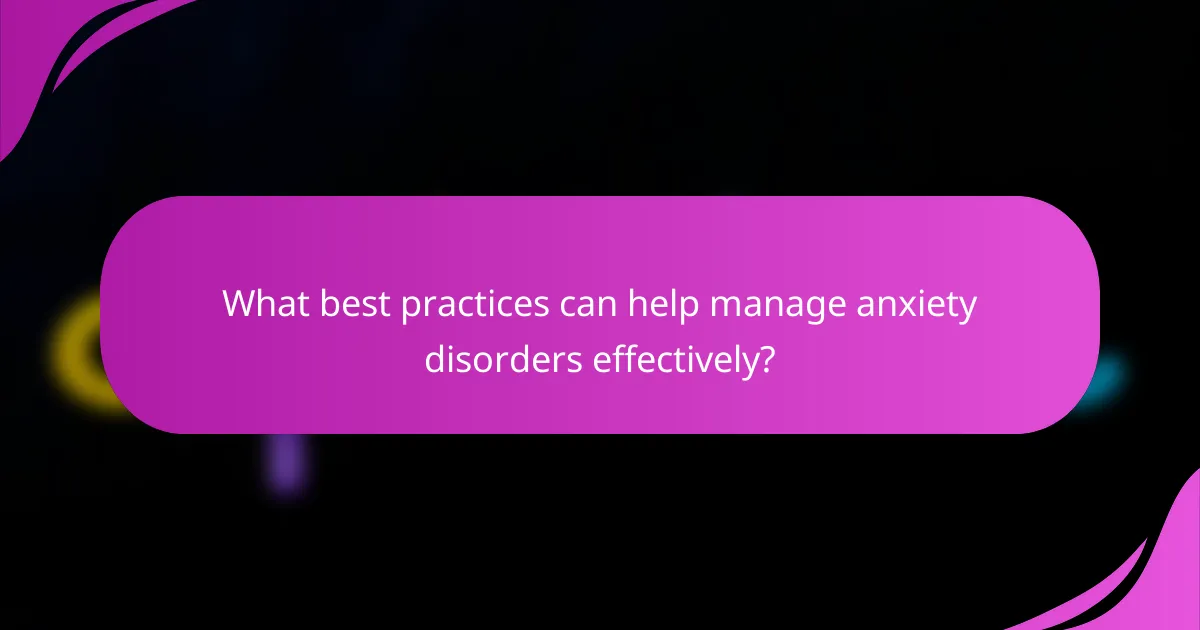
What best practices can help manage anxiety disorders effectively?
Cognitive-behavioral therapy, medication, and mindfulness practices are effective for managing anxiety disorders. These strategies address symptoms, reduce triggers, and build coping skills. Regular exercise and healthy sleep patterns also play crucial roles. Incorporating a support system enhances treatment outcomes and fosters resilience.
What lifestyle changes can reduce anxiety symptoms?
Lifestyle changes can significantly reduce anxiety symptoms. Incorporating regular exercise, practicing mindfulness, and maintaining a balanced diet are effective strategies.
Exercise releases endorphins, which enhance mood and reduce stress. Mindfulness techniques, such as meditation, help manage negative thoughts. A nutritious diet supports overall mental health, providing essential nutrients that can affect mood regulation.
Additionally, establishing a consistent sleep schedule can improve sleep quality, further alleviating anxiety. Social support from friends and family can also play a crucial role in managing anxiety symptoms.
How can individuals create a supportive environment for recovery?
Individuals can create a supportive environment for recovery by fostering open communication and understanding. Establishing a safe space encourages sharing feelings and experiences, which is crucial for those with anxiety disorders.
Support networks play a vital role; friends and family should be educated about anxiety disorders to provide informed support. Regular check-ins help maintain connections and show care.
Incorporating calming practices, such as mindfulness and relaxation techniques, can enhance the recovery environment. These practices reduce stress and promote emotional well-being.
Setting realistic expectations and celebrating small achievements contribute to a positive atmosphere. Recognizing progress, no matter how minor, reinforces motivation and hope in the recovery journey.
What common mistakes should be avoided in anxiety treatment?
Avoiding common mistakes in anxiety treatment is crucial for effective management. Key errors include neglecting professional help, relying solely on self-help strategies, and not adhering to treatment plans.
Many individuals underestimate the importance of therapy, which can provide tailored coping mechanisms. Additionally, skipping prescribed medications or altering dosages without consulting a healthcare provider can hinder progress. Lastly, failing to track symptoms and triggers can prevent individuals from recognizing patterns and making informed adjustments to their treatment.
What expert insights can enhance understanding of anxiety disorders?
Expert insights can significantly enhance understanding of anxiety disorders. Recognizing the multifaceted nature of symptoms, which can include excessive worry and physical manifestations, is crucial. Research indicates that genetic, environmental, and psychological factors contribute to the development of these disorders. Effective treatments often combine therapy, such as cognitive-behavioral therapy, with medication options tailored to individual needs. This comprehensive approach addresses both root and unique attributes of anxiety disorders, leading to better outcomes for those affected.
